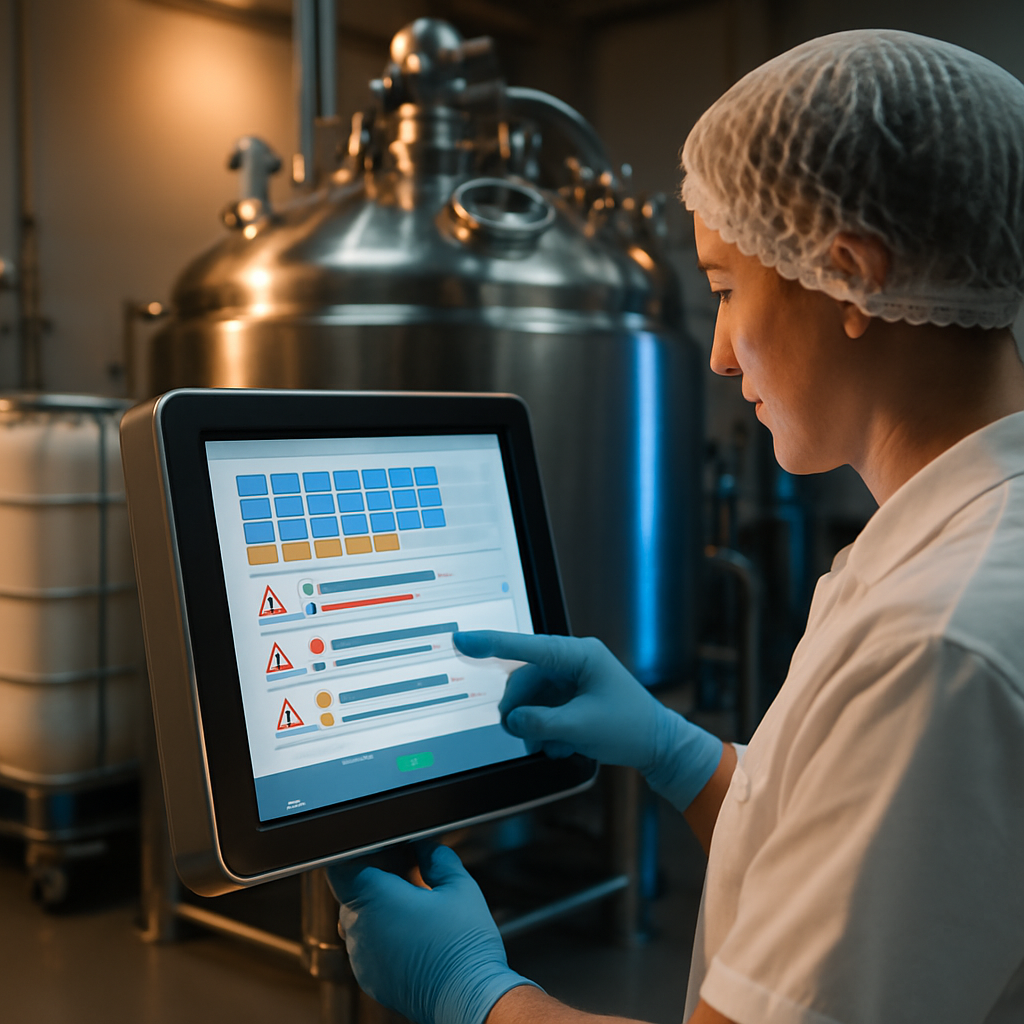Emerging ERP Market Trends in Manufacturing for 2026 and Beyond
Are you confident your ERP system can keep pace with what’s coming? Manufacturers are already rethinking what ERP should do, moving beyond...
7 min read
 Blake Snider
:
Nov 7, 2025 7:00:00 AM
Blake Snider
:
Nov 7, 2025 7:00:00 AM
For decades, Enterprise Resource Planning (ERP) systems have been the reliable, if rigid, system of record for manufacturers. They managed financials, orders, and inventory. But in the era of Industry 4.0, "reliable" is no longer enough. Today's smart manufacturing leaders face pressure to automate, predict failures, and respond to supply chain disruptions in real-time. This digital transformation is powered by a flood of data from IoT sensors, automated machinery, and connected assets.
The problem is that legacy ERP systems were never built to handle this. They are data silos, incapable of integrating with the real-time operational technologies on the shop floor. For CIOs and innovation leaders, this gap is the single biggest blocker to creating a true smart factory.
A modern manufacturing ERP, however, is designed to be the central nervous system of the entire operation. It integrates IoT data, AI models, and Manufacturing Execution Systems (MES) to provide a single, actionable source of truth. This article explores how modern platforms, specifically IFS Cloud, function as the essential hub for integrating these technologies and powering your digital transformation.
Legacy ERP systems were designed for a different era—one of manual data entry and monthly reporting. In modern manufacturing, these systems are no longer assets; they are bottlenecks. They cannot process the sheer volume, velocity, and variety of data generated by an Industry 4.0 environment, creating a critical gap between insight and action.
Legacy ERPs are monolithic by design. They trap financial, inventory, and order data in one database, while crucial production data lives separately in a Manufacturing Execution System (MES), a SCADA system, or disconnected spreadsheets. This separation makes a single source of truth impossible. It forces teams to make critical decisions based on outdated, incomplete information, rendering agile responses impossible.
Smart manufacturing runs on data from IoT sensors, PLCs, and edge devices. Legacy systems fundamentally lack the native APIs and flexible data models required to ingest this high-speed data stream. This means a sensor detecting a potential machine failure cannot automatically trigger a maintenance work order or adjust production schedules within the ERP. The "smart" data from the shop floor never reaches the "planning" system, leaving value on the table.
Want to add a digital twin to simulate your line? Or deploy a new predictive analytics model to forecast demand? With most legacy systems, this requires costly, high-risk customization projects that can take months or even years. This rigid, closed architecture prevents innovation leaders from testing and deploying the very advanced technologies needed to stay competitive. This is a common problem with many of the top ERP systems for manufacturing that have not been architected for modern connectivity.
A modern ERP for smart manufacturing flips the script, acting as an open, intelligent hub rather than a closed database. It is designed specifically to integrate and contextualize real-time data from all of your diverse sources. This integrated system connects the entire manufacturing process, from supply chain and production to asset management and customer service.
This integration is the foundational layer of any smart factory. A modern platform like IFS uses open APIs to connect directly to your IoT sensors and data platforms. This integration means sensor data—like temperature, vibration, or cycle count—isn't just collected; it's immediately associated with a specific asset, work order, and inventory item inside the ERP. This enables real-time monitoring of OEE (Overall Equipment Effectiveness) and asset health from a single business-wide dashboard.
Once high-quality data is centralized, artificial intelligence can be applied to automate and optimize. IFS embeds AI and machine learning models directly into its core processes. For example, AI algorithms analyze historical sensor data and real-time IoT feeds to forecast a part's failure, automatically triggering a predictive maintenance work order and ensuring the right technician and spare part are ready. This same AI can optimize production schedules on the fly or detect quality control anomalies far more accurately than a human operator.
However, reliable AI hinges on more than just the algorithm; it requires an enterprise-grade data strategy. This starts with ensuring high-quality, clean data as a prerequisite. Furthermore, the system must support MLOps (Machine Learning Operations) practices, including continuous model monitoring to detect data drift and automated retraining cadences to ensure the AI's predictions remain accurate at scale.
Modern ERPs provide the rich, structured data needed to build and maintain a digital twin—a high-fidelity virtual model of a physical asset, production line, or even your entire supply chain. As Forbes notes, this allows leaders to simulate the impact of a new production layout, test a new product run, or model supply chain disruptions before committing physical resources. An IFS ERP can feed this digital twin with real-time data on asset condition, inventory levels, and maintenance schedules for unparalleled accuracy.
The ERP plans what to make, and the Manufacturing Execution System (MES) manages how it gets made on the shop floor. A modern ERP provides seamless, bi-directional integration with your MES. When the ERP adjusts a production schedule due to a supply chain delay, that change is instantly reflected in the MES for operators on the line. This closes the loop between business planning and production execution, ensuring total alignment.
IFS is uniquely positioned for this new manufacturing paradigm because it was not built as a traditional, finance-first ERP. Its architecture is composable, meaning it's built from modular business capabilities that can be easily assembled and reassembled. This makes it ideal for integrating the complex, event-driven technologies of Industry 4.0.
Unlike monolithic systems, IFS's architecture is designed for connectivity from the ground up. This "API-first" approach simplifies the integration of third-party IoT platforms, AI services, and specialized MES solutions. For a CIO, this means a significantly faster time-to-value when launching a new smart factory initiative and a lower total cost of ownership, as integrations are managed as simple configurations, not complex, hard-coded projects.
IFS embeds its AI capabilities directly into the applications your teams already use, driving real-world automation. A practical example is in demand forecasting. The system can analyze historical sales data, current market trends, and even external data (like weather or port delays) to create a far more accurate forecast. This forecast then automatically adjusts procurement orders and production schedules, optimizing inventory and resource allocation.
For smart manufacturing, the ERP must manage the entire lifecycle of an asset, from procurement and installation to operation and retirement. IFS excels here by natively combining EAM (Enterprise Asset Management) with ERP and MES. This means the system tracks an asset's total cost, complete maintenance history, and real-time performance data. This enables a true performance-based maintenance strategy rather than relying on simple preventative schedules.
For a CIO, true integration is impossible without governance. A modern architecture must embrace open standards for interoperability while enforcing a robust security posture. IFS's foundation is built to support key industry protocols like OPC UA for interoperability and MQTT/AMQP for lightweight data messaging. This ensures it can communicate with a diverse ecosystem of shop-floor equipment and aligns with data models defined by ISA-95 standards. This connectivity is secured by adhering to modern principles like the NIST Cybersecurity Framework and supporting a Zero Trust approach for all connected assets.
Adopting an integrated ERP system is not just a technology upgrade; it's a fundamental business strategy that delivers measurable ROI. By unifying data from IoT, MES, and AI, manufacturers can move from a reactive to a predictive operational model. As of late 2025, companies making this shift are reporting significant, durable competitive advantages.
When your ERP and MES are fully integrated, manual data entry between systems is completely eliminated, reducing errors and saving thousands of work-hours. When production schedules are automatically-yet-intelligently optimized by AI based on real-time machine availability, your throughput increases. For example, a mid-sized discrete manufacturer implementing an integrated IFS solution saw a 30% reduction in unplanned machine downtime, a 4.2-point increase in first-pass yield, and improved schedule adherence by 9 points within the first 120 days. This deep integration powers a leaner, faster, and more profitable manufacturing operation from end to end.
Smart manufacturing isn't just about what happens inside your factory; it's about the entire supply chain. An integrated ERP provides end-to-end visibility. When an IoT sensor on a delivery truck signals a delay, the ERP can instantly assess the impact on production schedules and, using AI, suggest the best alternative (e.g., source from a different supplier or re-route another shipment), mitigating supply chain disruptions before they stop the line.
By capturing sensor and MES data directly in the ERP, manufacturers create a perfect, immutable digital record for every product manufactured. This "digital thread" provides granular traceability essential for compliance and quality control. If a quality issue is detected, a manufacturer can instantly trace the problem back to a specific batch of raw materials, a single machine setting, or a specific operator, drastically reducing the scope and cost of a potential recall.
Moving to an Industry 4.0-ready ERP system is a significant digital transformation journey. It requires a clear vision, a strategic roadmap, and the right technology partner. For CIOs and innovation leaders, the process is one of phased integration, not a disruptive "big bang" replacement.
Before you can integrate, you must map what you have. Identify all your current data sources (sensors, PLCs, MES, spreadsheets), identify your biggest operational bottlenecks, and define your key business goals. Are you focused on reducing downtime (predictive maintenance) or improving throughput (schedule optimization)? This clarity will define the project's priorities.
Do not try to boil the ocean. A successful smart factory roadmap starts with establishing connectivity (IoT integration), then standardizing execution (MES integration), and finally optimizing the entire business (unifying with ERP and AI). This phased approach delivers incremental, measurable value at each step and builds momentum for the larger transformation.
The right ERP software is only half the equation; the right implementation partner is the other half. You need a partner who understands the nuances of modern manufacturing and the technical architecture of platforms like IFS. An expert partner ensures your integration is built for scalability, security, and alignment with your long-term strategic goals.
The era of legacy ERP is over. Smart manufacturing and Industry 4.0 demand a system that can act as the intelligent core of the entire operation, not just a back-office accounting tool. This modern ERP must be able to integrate IoT, AI, digital twins, and MES to turn a flood of data into actionable, automated business decisions.
Platforms like IFS are purpose-built for this new reality, providing the composable architecture and embedded intelligence required to connect the shop floor to the top floor. For CIOs and manufacturing leaders, this is the definitive path to digital transformation, enabling predictive maintenance, resilient supply chains, and unparalleled operational visibility.
Don't let an outdated ERP system be the bottleneck to your smart factory ambitions. If you're ready to build a more connected, intelligent, and efficient manufacturing operation, contact us for 4.0 IFS ERP implementation. Or, schedule an IFS ERP Demo today to see the technology in action.

Are you confident your ERP system can keep pace with what’s coming? Manufacturers are already rethinking what ERP should do, moving beyond...

Every hour of production downtime costs manufacturers an average of $260,000 (Source: Aberdeen Research). Yet many companies still struggle with...

As of October 2025, the food and beverage industry operates on razor-thin margins under immense pressure from regulators and consumers. Food and...